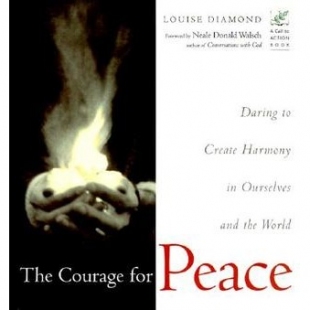"We each need to discover our own relationship with violence. Even if we hold a strong moral or ethical view about the importance of nonviolence, we need to come to terms with our own experiences of frustration and rage that can turn into violent action. I discovered this through an intense and difficult process. . . .
"The preparation took several forms, one of which was to deal with my own strong aversion to violence. I understood that if I were to work in war zones, I would be exposed to a level of violence previously unknown in my life, and to the people who were both perpetrators and victims of that violence. I would likely face soldiers with weapons, and sometimes those weapons might be pointed at me! Me, who avoided conflicts at all costs, and wanted to run when anyone even raised their voice — I would have to stand in the midst of fighting, and offer myself as a guide and witness to a better way.
"To do this, I realized, I would need to operate in such a setting without reacting — without immediately judging the participants or shrinking from the reality and totality of their experience. I could not afford to let my own revulsion get in the way of understanding the dynamics of the conflict, and its effects on all the parties, including the ones holding the weapons.
"In order to deal with this aversion to violence, I decided to psychologically desensitize myself. I spent a year going to every war movie I could ever find, and reading stacks of soldiers' memoirs and true life accounts of wartime adventures. I didn't limit myself only to the tales of soldiers. I also read about the experiences of doctors and nurses, bystanders and victims, leaders and followers.
"At first I would have to leave the theater in the middle of the film or close the book partway through. Gradually, I was able to stay to the end, without running away. I began to come to terms with the experience of violence, and the profound damage it does to all the parties involved.
"There came a time when I noticed a slight shift over some invisible boundary, when I started to feel inside myself the thrill of the kill that was portrayed in these books and movies. It was subtle at first, but eventually I had to admit that I was having a visceral experience of what people call bloodlust. I could understand the rush, the heightened state that some soldiers described, as they poured the power of destruction onto the 'enemy.'
"I could also experience the fear of the firefight, the terror of the trenches or the night patrol, the horror of seeing your friends blown apart beside you, and how that horror could be translated into unthinking brutality against fellow human beings. At the same time, I came to relate to the desire and willingness to live through this kind of nightmare for the greater good — the intention to serve and protect the people. When I came to know in myself this range of emotions and possibilities, I met the warrior within, with all her potential for violence and for service, and I was humbled.
"What grew in that strange year, with the juxtaposition of offering loving care to my failing parents while simultaneously immersing myself in horrific war stories, was a view of both the particle and the wave. As the particle, I found myself capable, given the right circumstances, of being just as vicious as the most bloodthirsty killer. As the wave, I understood the nature of human suffering when we stray so far from the Spirit of Peace.
"Overall, the result was the birth of deep compassion in me, for all of us who cause hurt to, and have been hurt by, one another. Armed only with this compassion, I felt ready to take my place as a peacebuilder in places of deep-rooted conflict around the world."
